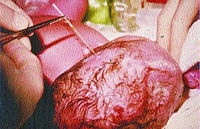3 wrong-side brain surgeries performed at Rhode Island hospital
An experienced brain surgeon insisted he knew what side of the head to operate on - but got it wrong.

Another time, a doctor-in-training cut into the wrong side of a patient's head after skipping a pre-op checklist. In a third case, the chief resident started brain surgery in the wrong place, and the nurse did not stop him.
All three mistakes happened at the same hospital in less than a year - Rhode Island Hospital, the state's most prestigious medical center and a teaching hospital for the Ivy League's Brown University.
That was startling enough, but just as surprising was that the errors happened despite an explicit set of required operating-room precautions adopted by the medical profession a few years ago to prevent "wrong-site surgery" mistakes. Those measures include the use of checklists, "time-outs" to double-check everything is correct, and indelible markers to show the surgeon where to cut.
"The problem's not going away," said Peter Angood, vice president and chief patient safety officer at the Joint Commission, an independent organization that accredits most of the nation's hospitals. "Organizations don't like to do this. It's complicated for them to do. Surgeons tend to resist it."
The mistakes at Rhode Island Hospital suggest that the precautions can still be thwarted by the human element _ ego and overconfidence on the part of surgeons, and timidity on the part of nurses too afraid to speak up when they see something about to go wrong.
"There's a big cultural issue in most operating rooms where there's a hierarchical culture there. A surgeon is used to being the captain of the ship, and his or her word goes," said Diane Rydrych, assistant director of the division of health policy at the Minnesota Health Department. "If there's a culture where people are afraid to say anything to the surgeon because they're afraid they're going to get yelled at, that's a problem."
The Joint Commission gets about eight reports a month of wrong-site surgery, but hospitals are not required to report such incidents, and Angood said the real number is probably 10 times higher. (The commission received only five or six reports a month in 2002, before the precautions took effect, but attributes the increase since then to better reporting, not more errors.)
After the third mistake at Rhode Island Hospital, the institution was fined $50,000 (34,460 EUR), ordered to tighten up its procedures and required to report to the state every time a doctor fails to follow the rules. The hospital also took unspecified "corrective action" against the doctors and nurses.
Rhode Island Hospital performed neurosurgery more than 860 times in fiscal year 2007. While three wrong-site mistakes represent just a small percentage, it is unusual for any one hospital to have so many, doctors said.
The first was in January, when a third-year resident did not mark the place where he was supposed to put a drain in an elderly man's head, according to Lifespan.
In July, a surgeon with more than two decades in medicine never wrote on a consent form which side of an 86-year-old man's head he would operate on to remove a blood clot, Cooper said. A nurse questioned why that was not filled out, and the surgeon said he remembered which side.
She asked him again if he was certain, he said he was sure, and she let him continue, Cooper said. The man's head was marked, but on the wrong side, Lifespan spokeswoman Gail Carvelli said.
In November, during an operation on an elderly woman, the hospital's chief neurosurgery resident and a nurse discussed the correct side ahead of time, Cooper said. But for reasons that are unclear, doctor marked and cut into the woman's scalp on the wrong side, and the nurse did not stop him, according to Cooper.
An investigation by the state Health Department said the hospital-approved checklist that was used did not do a good enough job of noting which side to operate on, said department spokeswoman Andrea Bagnall Degos.
In the first two cases, the surgeon cut all the way through the skull; in the third case, the doctor stopped after cutting into the scalp.
In all three cases, the doctor immediately closed the wound and operated on the correct side. The patients were OK, though the man in the July operation died a few weeks later from what the Heath Department said were unrelated causes.
Surgeons are supposed to follow a three-step process called the "Universal Protocol" put in place in 2003 by the Joint Commission: They make sure they are about to do the correct operation, usually via a checklist. They write on the patient's body with a marker - often scrawling "YES" - to note where they will operate. And they call a brief time-out just before starting.
In a time-out, the doctor might say something like: "This is Mrs. Smith. She's here for a left brain tumor. We're doing a left-sided craniotomy."
"If everybody's in agreement, then and only then will the knife get handed to the surgeon," said Sean Grady, chief of neurosurgery at the University of Pennsylvania medical school. "The nurses are empowered to stop the operation," he added. "It has not been part of the culture until quite recently."
David Gifford, head of the Rhode Island Health Department, said: "To do that double-check takes maybe a minute or two. To operate on the wrong side, that takes more than a minute or two."
Subscribe to Pravda.Ru Telegram channel, Facebook, RSS!


